|
What is a Cuboctahedron?
A cuboctahedron is a figure, which is formed by six squares
and eight equilateral triangles.
Two views follow:
A square and a triangle are lying parallel to the drawing
plane.
Therefore these figures are true to the original.
Obviously the name cuboctahedron
is formed by the words cube and octahedron.
...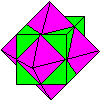 ... ...
|
If you set squared pyramids on the faces of the cube,
you can imagine that a (green) cube and a (red) octahedron penetrate each
other.
The intersection is the cuboctahedron. |
The cuboctahedron belongs
to the 13 Archimedean solids. I made a page
(in German only).
Those who know how to use
the 3D-View, can see the cuboctahedron threedimensionally.
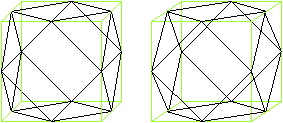
You can recognize that the cuboctahedron can develop from
a (green) cube. You connect the centres of the cube edges. Thus eight pyramids
arise, which you must cut off. The remaining solid is the cuboctahedron.
The cube is called " the producing cube" on this page.
Special Views
top

Variables
of the Cuboctahedron
top
The length of the edge of the cuboctahedron
is given as a.
Then you can calculate the Radius
R of the circumscribed sphere, the volume V, the area O, the distance
d3 of the triangles, and the distance d4 of the squares.
There is

Derivations
Area
If a is the length of the edge of the cuboctahedron,
the surface ist O=6*a²+8*(1/4)sqrt(3)a²=[6+2sqrt(3)]a².
You use the area formulas A=(1/4)sqrt(3)a² of the
equilateral triangle and A=a² of the square.
Volume
The producing cube has the edge length sqrt(2)a.
Subtract the volumes of the eight triangle pyramids from
the volume of the producing cube.
Volume of the pyramid

|
The formula is V=base*height/3. The triangle in front
is chosen as the base.
There is V'=(a²/4)*[(1/2)sqrt(2)a]/3=(1/24)sqrt(2)a³. |
Thus the volume of the cuboctahedron is V=2sqrt(2)a³-8V'
= 2sqrt(2)a³-8(1/24)sqrt(2)a³ = (5/3)sqrt(2)a³.
Thickness
Two squares lie in opposite to each other.
Their distance is d1=sqrt(2)a.
Two triangles lie in opposite to each other.
Their distance d2 is the length of the space
diagonal of the cube sqrt(3)[sqrt(2)a]=sqrt(6)a, decreased by the double
height of the corner pyramid. The height h is related to the base "eqilateral
triangle". There is V'=[(1/4)sqrt(3)a²]h/3=(1/12)sqrt(3)a²h or
V'=(1/24)sqrt(2)a³ (see above) for the volume of the triangle pyramid.
Thus there is h=(1/6)sqrt(6)a.
The searched distance is d2=sqrt(6)a-2(1/6)sqrt(6)a
= (2/3)sqrt(6)a.
Circumscribed
sphere R

|
There is only drawn the producing cube.
You see R=a. |
If you know the hexagons inside the cuboctahedron,
R=a is simpler to be seen (below).
Inscribed
sphere
There is no inscribed sphere. It
has to touch all squares and triangles. But the distances are different.
Properties
top
Building an octahedron.
You can put together all eight triangle pyramids, which
were cut off the producing cube. They fit the cube.
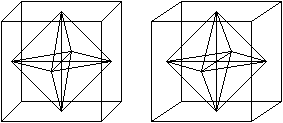
Hexagons
There are pairs of triangles at
the cuboctahedron. In the middle planes there are regular hexagons
as borders.
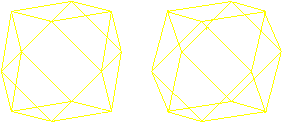
There are four different hexagons.
Now you see, why a circumscribed sphere exists. Its centre
is the centre of the cuboctahedron, the radius
is the edge length.
Closest
packing of spheres
If you lay around one (red) sphere
six equal spheres and lay in the dips three more spheres above and below,
then the centres of the (grey) spheres are the corners of a cuboctahedron.
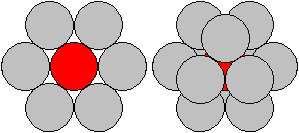
This leads to the closest packing of spheres in space. 12
spheres touch a central sphere.
In 2D six circles touch a central circle. 24 hyperspheres
touch a central hyperspheres in the fourdimensional case.
Numbers like 6,12,24 are called "kissing numbers".
Euler's path
Four edges meet at the corners of the cuboctahedron.
Therefore it is possible to follow the edges, so that you use the edges
once only.
You find more on my page House of
Santa Claus.
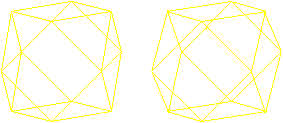
Net
top
If you spread out the cuboctahedron,
you get the following net from six squares and eight triangles. This is
one example.
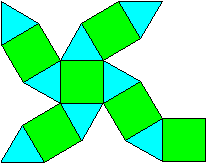
You see:
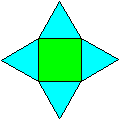
|
Every square is surrounded by four equilateral triangles. |
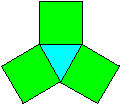
|
Every triangle is surrounded by three squares. |
There is a template in the
book (1) "M.C.Escher Kaleidozyklen".
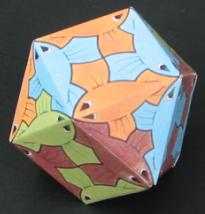
Rainbow Cube
top
...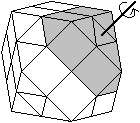 ... ... |
The cuboctahedron has become a puzzle similar to Rubik's
Cube. It is from Japan.
There are middle planes between the two triangles and
the hexagon. Thus you get a slice to every triangle, which you can turn
around an axis, which goes through the centre of the cubeoctahedron and
is perpendicular to the triangle.
On the left there is one of the eight slices drawn in
grey. |
...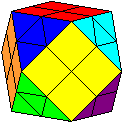 ... ... |
The surface of the cuboctahedron is coloured in a similar
way to Rubik's Cube. Opposite areas have the same colours.
If you turn some of the eight slices, the puzzle is out
of order. There is the aim now to reproduct one colour for all squares
and triangles. |
This is the puzzle:
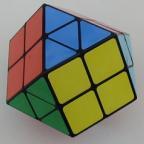
Cuboctahedron
on the Internet top
German
Claus Michael Ringel
Kuboktaeder
Geneviève Tulloue ( Figures Animées pour
la Physique )
Polyhedra
(Applets)
H. B. Meyer (Polyeder aus Flechtstreifen)
Kubo-Oktaeder
Wikipedia
Kuboktaeder,
Archimedischer
Körper, Großes
Rhombenkuboktaeder, Rhombendodekaeder
English
Eric W. Weisstein (MathWorld)
Cuboctahedron,
Triangular
Cupola, Archimedean
Solid, Kissing
Number, Octahemioctahedron,
Cubohemioctahedron,
George W. Hart
Virtual
Polyhedra (The Encyclopedia of Polyhedra)
Gijs Korthals Altes
Paper
model Cuboctahedron
H. B. Meyer (Polyhedra plaited with paper strips)
Cuboctahedron
Jaap Scherphuis
Rainbow
Cube
Kenneth James Michael MacLean
THE
CUBEOCTAHEDRON
Poly
A program
for downloading (Poly is a shareware program for exploring and constructing
polyhedra)
Die meisten Zeichnungen auf dieser Seite entstanden
mit Hilfe dieses Programms.
Wikipedia
Cuboctahedron,
Truncated
cuboctahedron, Triangular
cupola, Rhombic
dodecahedron, Hemipolyhedron,
Cubohemioctahedron,
Octahemioctahedron
French
Robert FERRÉOL
CUBOCTAÈDRE
References
top
(1) Doris Schattenschneider und Wallace Walker, M.C.Escher
Kaleidozyklen, Köln 1992
Feedback: Email address on my main page
This
page is also available in German.
URL of
my Homepage:
https://www.mathematische-basteleien.de/
©
2004 Jürgen Köller
top |





 ...
...









 ...
... ...
...